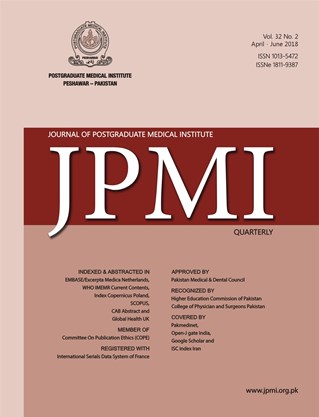COMPARISON OF 3.0% HYPERTONIC SALINE VERSUS 0.9% NORMAL SALINE NEBULIZATION FOR ACUTE BRONCHIOLITIS IN CHILDREN
Main Article Content
Abstract
Objective: To compare the use of 3.0% hypertonic saline versus 0.9% normal saline for nebulization in children who presented with acute bronchiolitis.
Methodology: We included 76 children having age less than 2 years who pre- sented with acute bronchiolitis in Emergency Department of Nishtar Hospital, Multan, from September 2016 to April 2107. In group I patients, 0.9% normal saline was used for nebulization; and in group II patients 3.0% hypertonic sa- line was used for nebulization. Nebulization was repeated after every 6 hours. Reduction in modified respiratory assessment (MRA) score after 48 hours and hospital stay were primary outcomes of study.
Results: In our study, most of children were in age group of <6 months. The MRA score after 48 hours of nebulization was 4.89 +1.22 in normal saline group versus 3.34 +1.05 in patients of hypertonic saline group (p value <0.001). Re- duction in MRA score was more in hypertonic saline group as compared to normal saline group. Mean hospital stay was 4.47 +1.03 days in normal saline group and 3.47 +0.89 in hypertonic saline group (P value <0.001).
Conclusion: Hypertonic saline resulted in significant reductions in modified re- spiratory assessment score (MRAS) and hospital stay as compared to normal saline in children with acute bronchiolitis.
Article Details
Work published in JPMI is licensed under a
Creative Commons Attribution-NonCommercial 2.0 Generic License.
Authors are permitted and encouraged to post their work online (e.g., in institutional repositories or on their website) prior to and during the submission process, as it can lead to productive exchanges, as well as earlier and greater citation of published work.


